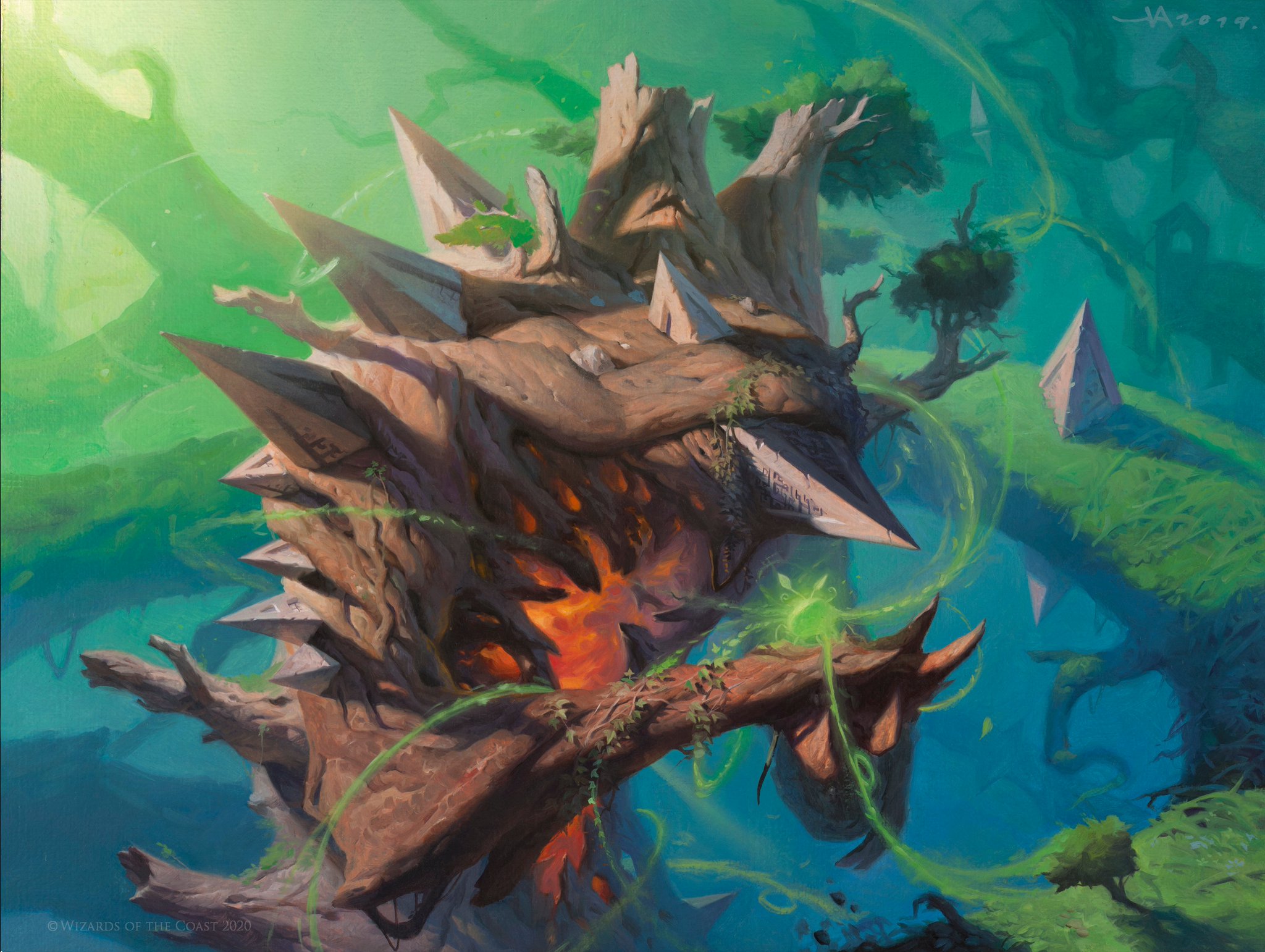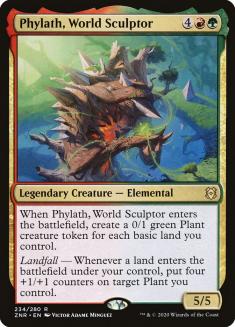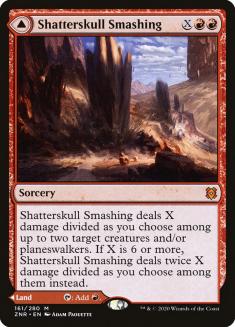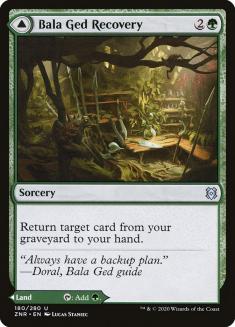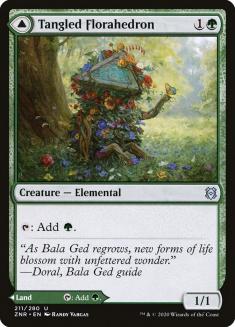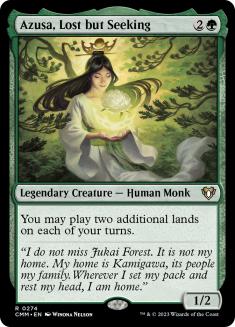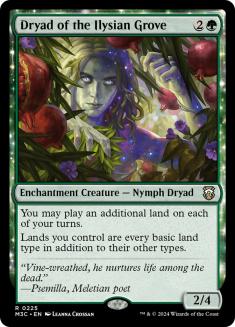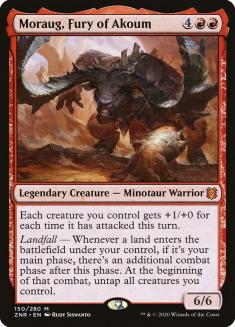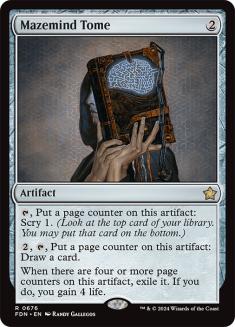There’s been plenty of good landfall cards in Magic’s history, but when you think of a Landfall deck, aggro strategies immediately come to mind. Whether it’s Paul Rietzl in the Top 8 of Pro Tour Paris with his Steppe Lynxes and Plated Geopedes or Snapping Gnarlid teaming up with the Temur Battle Rage / Become Immense combo at Pro Tour Battle for Zendikar, these decks have aimed to use fetchlands to create threats that are far above the curve and end the game in a hurry.
If you want to harken back to those times, it certainly looks like the tools are available in Zendikar Rising. Akoum Hellhound and Brushfire Elemental compare favorably to Steppe Lynx and Plated Geopede, and Skyclave Pick-Axe can lead to some very explosive draws.
There’s Always a But…
But…there’s a critical piece missing to this puzzle: fetchlands. You have access to Fabled Passage, but the previous Landfall Aggro decks played as many fetches as they could. They were hoping to play and sacrifice one each turn starting on Turn 2. And doubling up on landfall triggers so cheaply was a key part of those deck’s best draws. There’s a huge difference between your one-drop attacking for two, which is relatively common in Constructed, and attacking for four, which is incredible.
Maybe you can use cards like Cleansing Wildfire or Nahiri’s Lithoforming to generate those same explosive turns, but as anyone who remembers the many attempts at Scapeshift Aggro decks over the years knows, adding another moving part to the machine significantly reduces your consistency. Unsurprisingly, there’s no good replacement for fetchlands.
So now we have to take another direction. And when it comes to late-game landfall threats, the one that immediately comes to mind is Avenger of Zendikar. Avenger immediately created a huge battlefield presence, and it only took one or two landfall triggers afterward for the Plant tokens to dominate that battlefield. Even if they had an immediate answer to the Avenger, the Plant tokens often bought you enough time to dig for another threat.
Phylath, World Sculptor is this generation’s Avenger of Zendikar. It’s not quite as powerful as Avenger, but the ability to overload on one Plant token to go tall or go wide by pumping multiple Plants is quite valuable. Plus, costing one less mana is huge for any landfall creature, because you can start accumulating those triggers a turn earlier or set up a turn where you cast Phylath with a Fabled Passage or two sitting around so you’re guaranteed to get a trigger even in the face of removal like Heartless Act.
After one landfall trigger, you have generated nine power of bodies, thirteen after the second trigger, and so on. That’s enough value early to demand an immediate answer and enough value late to take over a game when left unchecked. It’s also one that can play defense if needed against an aggro deck, can turn the corner quickly by generating so much power, or can help you grind through a removal-heavy deck. You don’t often see that kind of versatility out of a Gruul creature. With Phylath as a high-end threat, I’m interested in moving away from Landfall Aggro and toward a more robust shell.
You can never have too many mana sinks in a landfall deck.
Of course, by transitioning to a strategy that’s less aggressive, you introduce another problem. Landfall works nicely for aggro because you end the game before you run out of gas, at which point your threats become embarrassing pieces of cardboard. Even more expensive landfall threats look poor if you’re not continuing to make land drops consistently on the following turns.
The tension here is that you need an abnormally high land count to make sure you’re triggering landfall often enough for your payoffs to be effective, but doing so leaves you with fewer overall threats, making it easier for your opponent to trade for your payoff threats, even if they have to use more than one card. This is where the various double-faced cards that are a land on one side and a spell on the other are so important. These decks have the capability of playing an artificially high land count while still having relevant spells as the game goes long.
Paulo Vitor Damo da Rosa will cover the cycle of mythic double-faced cards once the cycle is complete, but I’d be remiss if I didn’t note that I’m very high on Shatterskull Smashing, especially in a landfall deck. Typically you’ll be playing these cards as lands most often in the early-game, so the best ones will be those that are most relevant in the mid to late-game. Shatterskull Smashing is, in my opinion, the most powerful effect in the cycle because it can function as a fine removal spell on Turn 4 but is absolutely game-breaking when you top deck it late.
Landfall decks naturally play to game states where they have tons of mana, so having effective sinks to utilize all that mana is key to letting them operate on every cylinder. Shatterskull Smashing is going to be a great draw almost every time you see it. Similarly, I’m high on Bala Ged Recovery, which is also a great topdeck late, though not as strong in the mid-game.
I also like Tangled Florahedron, which offers acceleration early, but landfall triggers late. In most ramp decks, either side will be weak when you draw it late, but this deck is happy to keep triggering landfall, and without access to Growth Spiral, having a secondary mana creature on Turn 2 to supplement Lotus Cobra is most welcome.
Knowing that you want to overload on double-faced cards, consider the following decklist:
Creatures (24)
- 2 Azusa, Lost but Seeking
- 4 Lotus Cobra
- 3 Dryad of the Ilysian Grove
- 4 Radha, Heart of Keld
- 4 Tangled Florahedron
- 3 Moraug, Fury of Akoum
- 4 Phylath, World Sculptor
Lands (22)
Spells (14)

This deck only plays 22 actual lands, but it has an effective land count of 34, so you won’t have any problems making land drops. With eight basics and six lands that search for them, you should have enough to get all the Plants you need from Phylath, but I would consider cutting down on two-color lands for more basics if you want to buff that card some more. The high land count makes those much less important, since you have less trouble finding the colors you need.
The key element of this list is the combo of Radha, Heart of Keld and Dryad of the Ilysian Grove. It reminds me of the old engine of Jace, the Mind Sculptor and Oracle of Mul Daya. These cards aren’t as powerful standalone cards, but in a deck that effectively plays so many lands, the engine has more fuel than it did before. I also love that Radha’s activated ability is another mana sink that comes along at no cost. You can never have too many mana sinks in a landfall deck.
It’s tempting to play more copies of Azusa, Lost but Seeking here because its ability is more powerful than Dryad, but there are a lot of other variables that lead me to favor Dryad’s in the split. One is that Dryad is a 2/4, which makes it a more effective roadblock against aggro decks and more resilient in the face of removal. With Stomp, Scorching Dragonfire, and now Roil Eruption around, that extra toughness is important.
Second, even in a two-color deck, Dryad’s other ability is relevant. It lets you leave your Fabled Passages and Field of Ruins on the battlefield without losing any development speed, thus setting you up for a much more explosive turn down the line. You see this a lot with fetchlands and Valakut, the Molten Pinnacle in Modern, and it’s no less important here to maximize every land.
Moraug, Fury of Akoum makes an appearance here as another landfall payoff, letting you turn your early creatures into substantial threats, but more importantly, it lets you make use out of your army of Plant tokens from Phylath, even if it’s removed before you get a landfall trigger from it. Even three leftover Plant tokens attack for a total of nine damage when followed by Moraug and one trigger.
The last maindeck card I want to remark on is Mazemind Tome. At first it can look out of place, but to me it’s a great glue card. It fills out the low-end of the curve with yet another spell that is a fine topdeck late in the game. It also manipulates your library to maximize Radha, Heart of Keld. And in attrition games, it provides significant card advantage. Personally, I expect Mazemind Tome to be a breakout card in Standard now that we’re moving to a format without Hydroid Krasis and Nissa, Who Shakes the World.
Time to Get Greedy
I tend to be conservative with my mana when brewing for a new format, because I don’t want to be biased in my early testing and dismiss a powerful shell because I tried to do too much in an early build. But with Dryad of the Ilysian Grove, Fabled Passage, and Lotus Cobra, the fixing is there to branch out of the traditional landfall colors. I’ve also been impressed by Omnath, Locus of Creation, another great landfall payoff, so here it is:
Creatures (27)
- 4 Lotus Cobra
- 3 Uro, Titan of Nature's Wrath
- 4 Dryad of the Ilysian Grove
- 4 Radha, Heart of Keld
- 4 Omnath, Locus of Creation
- 4 Tangled Florahedron
- 4 Phylath, World Sculptor
Lands (22)
Spells (11)
- 4 Genesis Ultimatum
- 2 Bala Ged Recovery
- 1 Sea Gate Restoration
- 3 Shatterskull Smashing
- 1 Turntimber Symbiosis
Sideboard

This deck has more raw power, and the mana looks solid. Triomes are incredible in a deck like this, since they continue to push the count of otherwise functional mana sources higher. It’s possible that Ketria Triome is better than Temple of Abandon in the Gruul list, for instance.
As much pedigree as Uro has, the major gain here in my mind is Omnath. Uro is going to play somewhat awkwardly in a deck with so many permanents and no clear way to fill the graveyard, but it’s powerful enough to make the cut even with the dis-synergy.
On the other hand, Omnath does everything. It’s powerful enough on its own that I expect it will see play outside of dedicated landfall decks. But being able to consistently get the second and third trigger elevates the card even further. The extra mana will help you establish your engine quickly, and the third ability, when triggered consistently, is going to lead to a lot of opponents being surprised at how quickly their life total dwindles. A few beatdowns from your motley crew and some Omnath triggers are more than enough to leave your opponent in single digits.
Adding blue also improves the sideboard by quite a bit, letting you fight more effectively against counterspells with Shark Typhoon and Mystical Dispute. Counterspells will always be the bane for ramp decks, and even though this deck plays better against counters due to its cheap creatures being able to apply pressure, it’s still great to have extra tools against the Shaheen Sooranis and other Neutralize-wielders of the world.
Who Can Ramp the Best?
We’re just getting out from under the iron grip of Growth Spiral and Nissa, Who Shakes the World, so I’m expecting players to shy away from ramp strategies. But there’s still plenty of good options to generate fast mana, so I don’t think it’s going anywhere. The key is to find a balance between proactively executing your own ramp plan and being able to play the necessary disruption to stop decks that are trying to go underneath you.
What I like about utilizing creatures like Lotus Cobra; Dryad of the Ilysian Grove; and Radha, Heart of Keld as your mana engine is that those creatures can play defense against aggro decks. It may feel bad to trade away your creatures before they generate value, but these decks are going to make their land drops, and as long as you survive to cast your big spells, they will take over. Phylath is that top-end spell, and the missing piece for this style of deck to come together.

